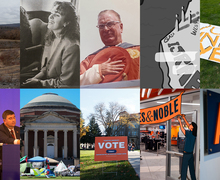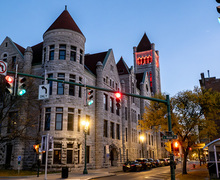Newhouse enacts printing policy to reserve resources, encourage conservation
About 500,000 sheets of paper are used each semester at the S.I. Newhouse School of Public Communications at Syracuse University.
In an effort to decrease that number, help reduce its environmental effect and better manage printing costs, Newhouse has updated its printing policy, effective this fall, according to an email sent out to all Newhouse students Aug. 17.
At the start of every academic year, Newhouse students will receive $25 on their SUpercard to use in any university and Newhouse computer lab, according to the email. Students can access an online management system where they can view their printing history and add money via cash in the Schine Student Center or through a credit card online, according to the email.
Students receive an email notification when their balance drops below $5, and again at $1, according to the email.
Brad Gorham, chair of the communications department, is a member of the committee Dean Lorraine Branham assembled with other faculty members to craft the policy.
‘We’re moving digitally as a school,’ Gorham said. ‘There was a real concern about the environment.’
Gorham said the committee first gathered data with the help of Peter Weinhold, assistant dean and director of technology for Newhouse.
‘We had been kind of thinking about this for a while. Once Peter came on board, he really pushed us to study and look at it,’ Gorham said.
He said they could see how many print jobs were going on in the labs and how much of that was one-sided versus double-sided. In addition to students printing large, non-academic projects, Gorham said some students were giving friends their Net IDs to use in the labs.
On average, a Newhouse student uses 300 sheets of paper and spends between $22 and $23 per semester. Gorham said they used this data to accommodate students.
‘Given the data, where could we draw the line where it would make a difference but wouldn’t impact most students?’ he said.
For an 8.5-by-11-inch sheet of paper, Newhouse charges 2 cents for black and white printing and 16 cents for color printing. For an 11-by-14-inch sheet, it costs 3 cents for black and white printing and 18 cents for color printing, according to the email.
Weinhold said the school’s new printing rates are actually cheaper than the rest of campus.
‘We contacted the campus administrator, and he said that our rates are comparable to other schools,’ Weinhold said. ‘It’s really a difference.’
For an 8.5-by-11-inch sheet, the rest of campus charges 4 cents for black and white printing and 50 cents for color printing, Weinhold said. He said other campus labs don’t offer an 11-by-14-inch size.
Weinhold said that after only a week, the volume of paper has already been dramatically reduced, but they would like to wait until the end of spring semester to get a good sample of data.
Gorham said he figured 30 to 45 percent of money will be saved with the new policy
Eden Ben-Haim, a sophomore advertising and finance major in Newhouse and the Martin J. Whitman School of Management, said he thinks the $25 printing fee is still enough to generate a wasteful amount of paper.
‘Newhouse is a communications school. Its students study journalism, graphic design, magazine and photography,’ he said. ‘I’m no expert, but those subjects usually require a lot of printing, free or not, which makes me dubious that printing will decrease a significant amount.’
Ben-Haim said he thinks if Newhouse wants to take measures against wasteful printing, they should enforce it through the curriculum. He said he thinks teachers should accept more assignments online and embrace digital work.
He said: ‘If Newhouse wants to make a difference, they should put in the effort to encourage green ways through the classrooms instead of taking away privileges from students.’
Published on September 7, 2011 at 12:00 pm
Contact Maddy: mjberner@syr.edu





